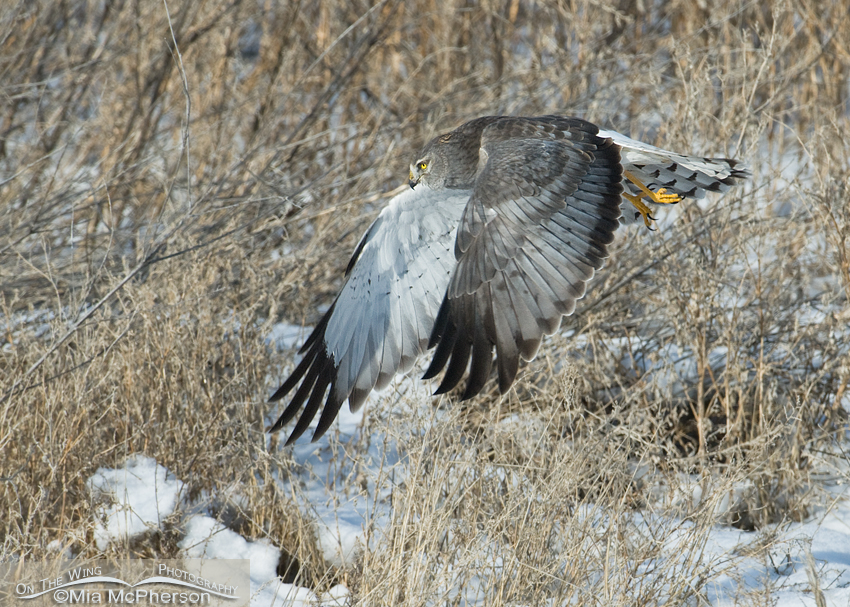 Northern Harrier male after lift off – Nikon D200, f6.3, 1/2000, ISO 400, Nikkor 200-400mm VR with 1.4x TC at 280 mm, natural light, not baited
Northern Harrier male after lift off – Nikon D200, f6.3, 1/2000, ISO 400, Nikkor 200-400mm VR with 1.4x TC at 280 mm, natural light, not baited
So ya think ya want to be a bird photographer?
Awhile ago a question was asked by a new member and aspiring bird photographer on a nature photography critique forum where I am a lifetime member that struck my funny bone and I just had to reply to their inquiry. The person basically wanted to know what the secret is to photographing birds and after thinking about it for a few moments I replied to their question, not just once but three times and honestly I could have posted much more to answer them.
I’m taking the liberty of editing my own words again instead of quoting directly from the thread. Some of my replies are serious, some are funny and tongue in cheek. Some are both. I’ll let you be the judge of when I am serious or not.
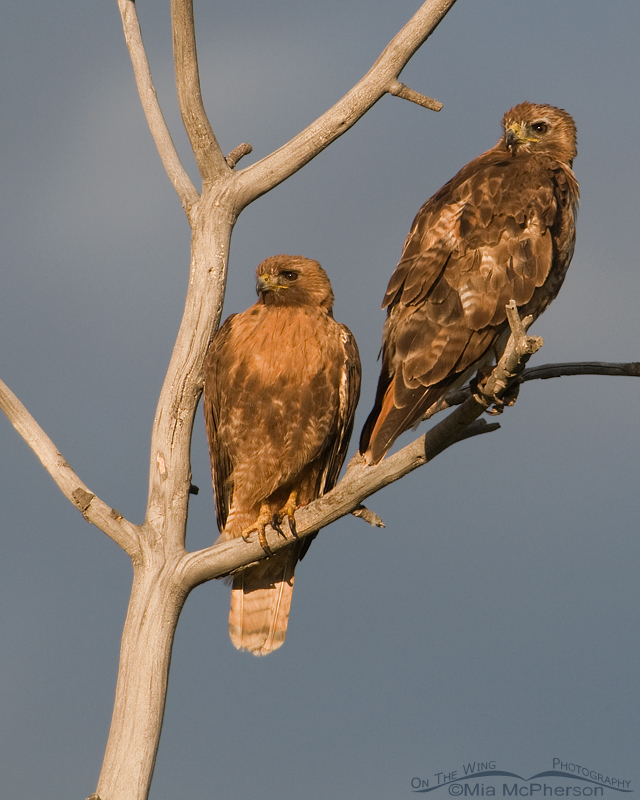 Red-tailed Hawks in Montana – Nikon D300, f7.1, 1/400, ISO 500, +0.3 EV, Nikkor 200-400mm VR with 1.4x TC at 400 mm, natural light, not baited
Red-tailed Hawks in Montana – Nikon D300, f7.1, 1/400, ISO 500, +0.3 EV, Nikkor 200-400mm VR with 1.4x TC at 400 mm, natural light, not baited
The most important is this:
There is NO magic or undisclosed secret to help with bird photography, it takes skill, it takes patience, it takes enormous time in the field, it takes practice, hard work and determination.
An important point:
The first thing I would suggest is to get a bird guide book, you have to be able to tell the difference between a domestic chicken & a grouse. Or how to tell what is a native turkey in the field and I’m talking about the ones with feathers at this point.
The “Children’s Golden Guide to Birds” is great for its intended audience but if you can afford to pay for your gear by yourself then you should look for a more grown up field guide. The illustrations, pictures and contents can help you enormously with bird identification.
Some of the bird guide books I would recommend are (in no particular order):
The Sibley Guide to Birds – David Sibley
National Geographic Field Guide to the Birds of North America – Dunn and Alderfer
National Audubon Society Field Guide to North American Birds
American Museum & Natural History – Birds of North America
The Stokes Field Guide to the Birds of North America – Donald & Lillian Stokes
Kaufman Field Guide to Birds of North America – Kenn Kaufman
The Birder’s Handbook – Ehrlich, Dobkin and Wheye
American Birding Association State Field Guides
Peterson Field Guide to Birds
For Beginners:
National Geographic Pocket Guide to the Birds of North America – Erickson and Alderfer (Two of my bird images are in this book)
There are many, many more excellent bird guide/reference books.
I use both the Audubon Birds and iBird Pro birding apps on my phone.
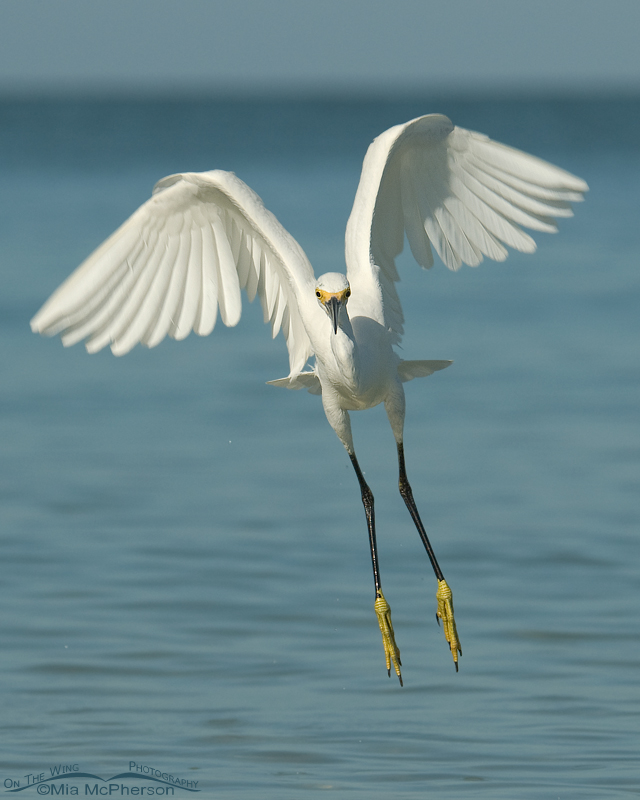 Snowy Egret in flight – Nikon D200, handheld, f6.3, 1/1500, ISO 200, Nikkor 80-400mm VR at 175mm, natural light
Snowy Egret in flight – Nikon D200, handheld, f6.3, 1/1500, ISO 200, Nikkor 80-400mm VR at 175mm, natural light
Read up on species in your local area, find out when they are there and what geographical locations they may be present in. Some birds do migrate, some don’t. Some migrating birds are more abundant in spring migration in certain locations than they are in the fall and vice versa.
Learn to recognize birds by sight and sound and find out what season you might expect to see them. And even better, study their behavior in the field because that can help you take some great action photos.
Remember this phrase “You won’t know if you don’t go“, get out in the field as often as you can.
Learn about exposure, white birds should look white and not muddy or gray in appearance. Black birds should look dark but not so dark as to not show any feather detail.
Know what the color a bird actually is for post processing later. An American Kestrel; for instance, shouldn’t look like it lives at a nuclear power plant by glowing far too brightly or if it is WAY too colorful to be natural & realistic. A Snowy Egret should not look like it fell into a vat of pale grey paint.
If the techs aren’t good, the image isn’t sharp and the exposure is bad nothing you do in Photoshop is going to make a poor image great.
Seriously, would you rather spend two hours trying to fix an image that is poor in quality and even after that amount of time invested know that it still isn’t going to be great or spend that two hours in the field trying to create that great image right out of the camera?? That is an easy answer for me. Get it right in the camera to save time on post processing later.
Review each of your images prior to deleting and ask yourself “What could I have done to make this image better?” Learn to develop a love/hate relationship with culling. I love it when I nail shots all day long, I hate it when I have messed up more images than I care to count.
Develop a callus on your behind because when you mess up you’ll spend a lot of time kicking your own butt.
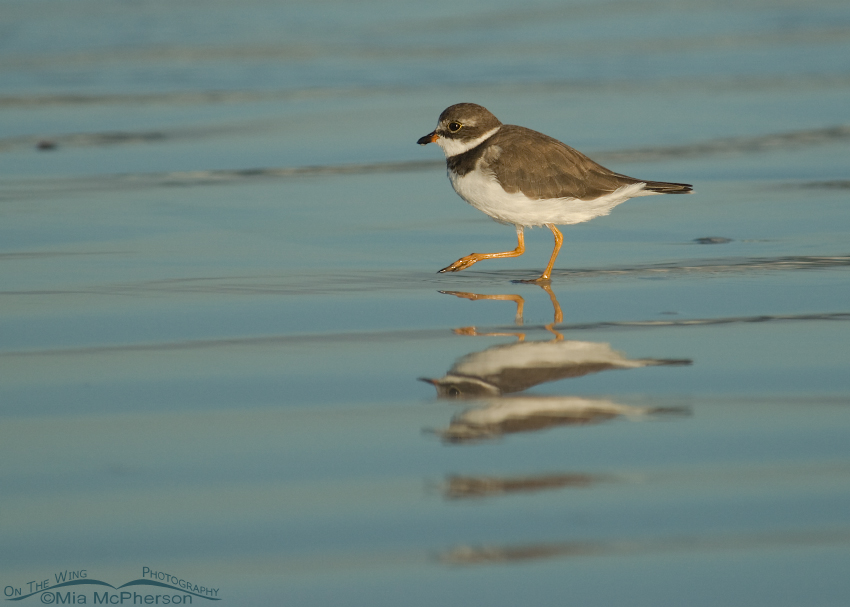 Low angle Semipalmated Plover adult – Nikon D200, handheld, f5.6, 1/1600, ISO 320, Nikkor 80-400mm VR at 400mm, natural light
Low angle Semipalmated Plover adult – Nikon D200, handheld, f5.6, 1/1600, ISO 320, Nikkor 80-400mm VR at 400mm, natural light
Bird photography is NOT glamorous. Trust me on that.
All of the photos you see where a bird photographer is smiling into the camera wearing clean, dry clothes were taken before they started photographing that day.
If you want to get that “low angle” bird photographers so often talk about be prepared to get dirty, learn how to belly crawl through mud, sand, grass, bird poop and things you don’t even want to think about. And when there is an algae bloom in the shallow water get some nose plugs or a portable oxygen tank.
Think of sand crawling as a free or low cost dermabrasion. Get your tetanus shots updated.
After laying in the sand whether it is wet or dry you will end up looking like a sugar-covered donut. You will have sand on your face, in your ears and in places where sand is not supposed to be. Think of it as a bird photographer’s equivalent to adorning oneself with glitter or tribal paint.
When it is hot while shooting you will sweat, NO amount of antiperspirant is strong enough. Your brow will sweat and it will run down into your eyes blinding you temporarily. Carry a kerchief, wipe your eyes as needed.
Carry an extra set of clothes and shoes for days you really get down & dirty shooting or you may have to make the drive home smelling like bird poop. At the very least carry a heavy towel to toss over your car seat or it may end up smelling like an old tuna can.
If you are shooting up at birds for long periods of time invest in a heating pad because your shoulders will scream at you. Or buy a partnership into a local massage parlor.
When photographing birds flying directly over your head be sure to keep your mouth closed as you never know when they might decide to flush out their systems.
Look before you sit, fire ants are not fun. Neither is sitting in goose poop. Shrimp do tickle when they walk around on your legs as you sit in the water photographing birds.
Get long johns, great gloves, heat packs and the warmest coats you can get if you are going to photograph in cold weather or you might freeze something off. I’ve sat for two hours in 20 degree weather waiting for hoar frost to melt off of the plumage of a Bald Eagle just to get a few lift off shots. Yes, I am addicted to bird photography.
Remember to wear sun protective clothing in the summer or you might toast your buns… or something else.
You may end up at the end of a shoot appearing to others like you have rolled around in the mud. If you got great shots that day, would it really matter?
There seems to be a “uniform” pro photographers wear, ignore that. Wear what you are comfortable in. Impress them with your photos not your clothes. I could wear a clown suit and still photograph birds.
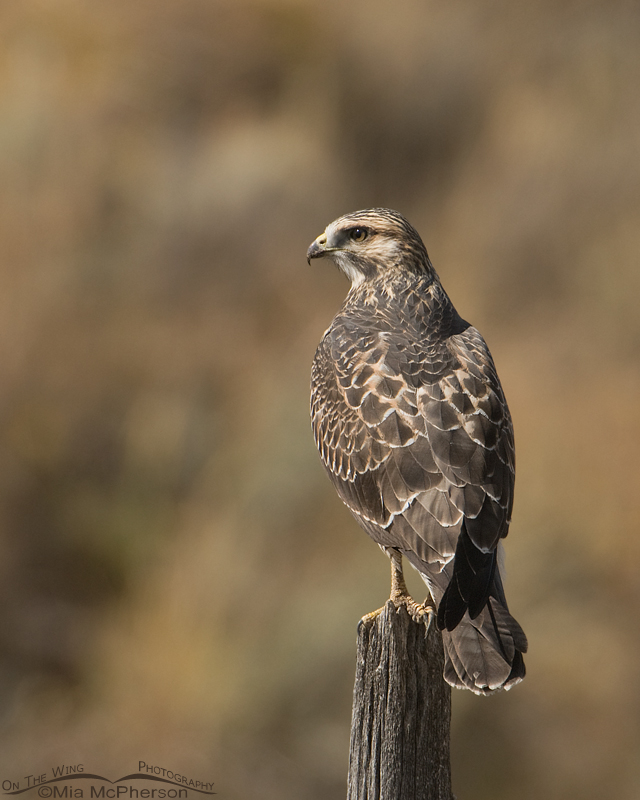 Swainson’s Hawk juvenile- Nikon D200, f7.1, 1/640, ISO 250, Nikkor 200-400mm VR with 1.4x TC at 400mm, natural light, not baited
Swainson’s Hawk juvenile- Nikon D200, f7.1, 1/640, ISO 250, Nikkor 200-400mm VR with 1.4x TC at 400mm, natural light, not baited
Be prepared
Be prepared to be frustrated. Be prepared to get many more blurry shots than you get that are sharp. Be prepared to get numerous images where you clip the wing tips, feet, bill, head, etc. Your sharpest shots from that series will be those clipped images. I kid you not.
Be prepared to sit for hours waiting for “the” shot. Be prepared to have missed it because you reached for your cup of coffee at the precise moment the bird did something fantastic.
Get a bumper sticker that says “Caution, Frequent Stops – Bird Photographer on Board” or be prepared to get rear-ended. Realize that non bird photographers don’t know why we drive erratically at times, they just think we are insane.
Buy cases of insect repellent. In some locations you may need pepper spray and not just for 4 legged animals.
Carry something to snack on or your stomach grumbling will scare off the birds. I’m serious!
Don’t leave your spare batteries or memory cards in the car, you will be sorry. In fact I can guarantee you will be sorry.
People might think you have “shifty eyes” when in fact you are simply scanning the sky, ground, grasses, trees, shrubs, lakes, rivers, mountain ridges, fence posts, power poles, clotheslines, brush piles, hedgerows, compost piles, swamps, canyon floors, beaches, sand dunes, marshes and even the city dump looking for potential subjects. I think you get my drift.
When a non-bird photographer shouts “Duck” you might be looking for waterfowl as a ball bounces off of your head.
Non-bird photographers will say “That camera must take good pictures” and what they don’t realize is that without us behind the viewfinder clicking the shutter button that the camera would just be an expensive paperweight. A really expensive paperweight.
Be prepared for non-bird photographers to look at you like you have horns growing out of your head. They don’t understand the language of bird photographers. You may as well be an alien.
Bird photographers do speak a different language, conversations are sprinkled with words like bokeh, aperture, depth of field, ISO, shutter speed and so on. Non-bird photographers don’t understand it and that doesn’t even take into consideration the terminology about the birds themselves. Eclipse plumage, juvie, molting, primaries, coverts, supercilium, vent, orbital rings, etc.. Say “Harrier” to a non-bird photographer and they might think “airplane”, say primaries and they might think of “political elections”, mention vent and they might just vent to you about something non-bird related.
If you talk to a non-bird photographer for five minutes about the ID of a bird their eyes will glaze over. If you talk to a non-bird photographer for 10 minutes about the technical difficulties of settings, light, composition and the like their pulse will slow, call 911 because they are certifiably bored to death.
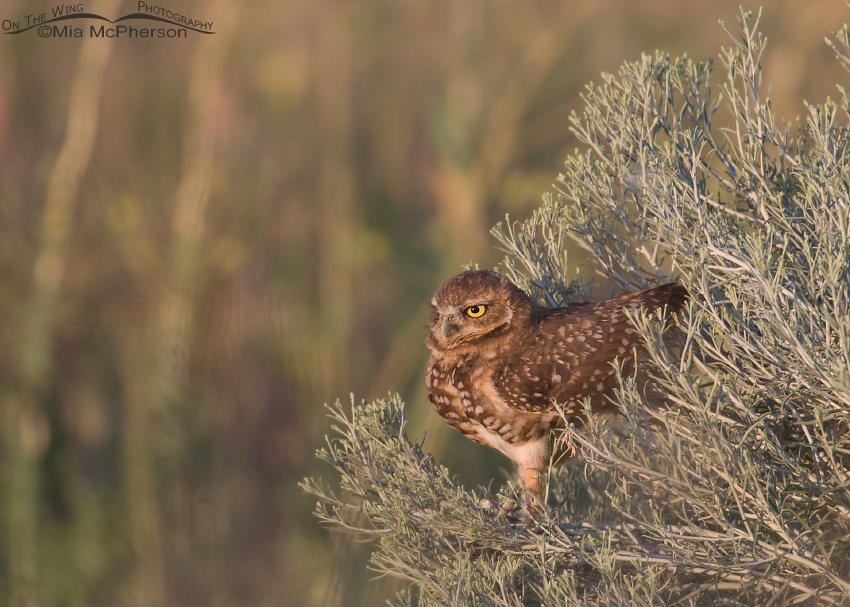 Juvenile Burrowing Owl – Nikon D200, f6.3, 1/320, ISO 320, Nikkor 200-400mm VR with 1.4x TC at 400mm, natural light, not baited
Juvenile Burrowing Owl – Nikon D200, f6.3, 1/320, ISO 320, Nikkor 200-400mm VR with 1.4x TC at 400mm, natural light, not baited
Know when you are getting too close to your subject by observing the bird’s behavior, you can tell when you get too close because they become alarmed. You don’t want to pet the bird, you want to photograph it.
Don’t mess with nesting birds. Don’t remove leaves so you can get better shots of nestlings, the adult used that spot for a reason; for instance, protective cover. Watch where you step, some ground nesting bird’s eggs are so well camouflaged you might step on them or the chicks. Don’t disturb nestlings or cause the parents undue stress.
Remember that we won’t have subjects to photograph if we don’t look out for their welfare today. Take a bigger crop than usual to stay a good distance away from chicks or young birds.
Follow local, state and federal guidelines & rules about how close to approach and what land you need to stay off of.
I repeat: Don’t mess with nesting birds.
There is NEVER a case where a photograph of a bird more is important than the safety, health and well being of the subject. Ever.
Pack out what you carry in. Even better; carry out trash that may have been left behind by careless people for the sake of birds and other wildlife. A pelican with a soiled disposable diaper in its bill isn’t a pretty sight and a bird with a missing foot caused by fishing line cutting it off is utterly disturbing.
Be considerate of other bird photographers when you approach them while they are on birds. I’ve spent long periods of time getting close to my subjects just to have some rude person walk up quickly to “grab a shot” who flush the birds I have so patiently approached. Most bird photographers are great people and don’t mind if you approach in a slow way and don’t flush the birds. Ask them about approaching them in a quiet voice, if you yell I hope you have good traction on your shoes.
Don’t jump in front of another photographer to get your shot. Or be prepared… for anything. Just saying…
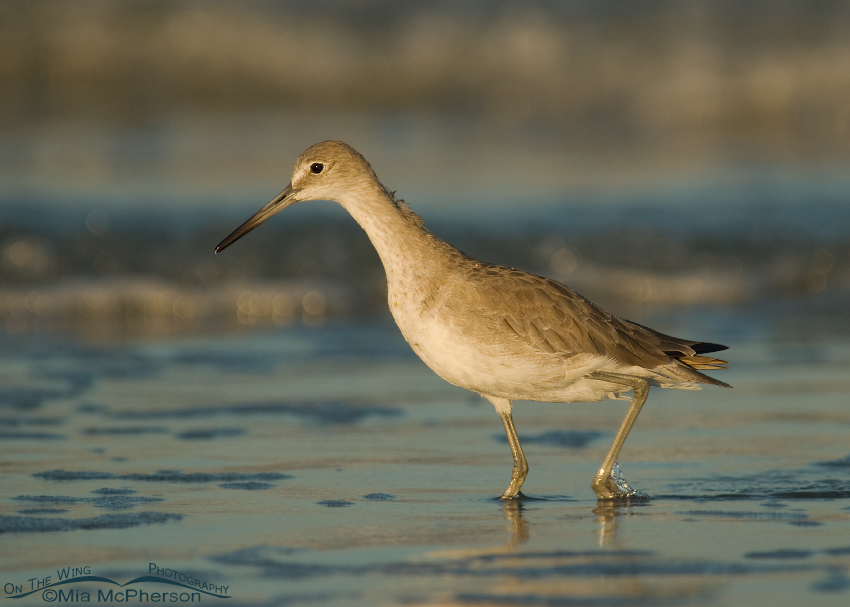 Willet foraging in early morning light – Nikon D200, handheld, f5.6, 1/1250, ISO 400, Nikkor 80-400mm VR at 400mm, natural light
Willet foraging in early morning light – Nikon D200, handheld, f5.6, 1/1250, ISO 400, Nikkor 80-400mm VR at 400mm, natural light
I shoot a lot without a tripod, handhold my 70-300mm VR, my 80-400mm VR, most of the time I am resting my 200-400mm VR on my noodle or shooting handheld in bursts. Perhaps less than 5% of my images are taken using a tripod. I know plenty of bird photographers who shoot handheld and get sharp images. Tripods can be handy though if you don’t have IS or VR or if you expect to be on the birds a long time.
Be aware that you may have to sell your first born to be able to pay for your “dream” lens. Just kidding… well maybe not.
If you hear someone say “I’d kill for that lens”… run like the wind. Seriously.
When your spouse or significant other asks why there is a second mortgage on the house pretend you have lost your hearing completely and hide the expensive lens.
Get used to getting up at o’dark hundred, you want to be there for early morning light.
You will dream about birds, it won’t be as bad as the movie “The Birds”, but it might get scary night after night. If you wake up after one of those dreams with a tickle in your throat do check for feathers.
Weather forecasters lie. If they predict “partly sunny” you’ll get thick heavy clouds with little light. If they predict a mostly cloudy morning chances are the sun will be shining. I wish I could get paid to be wrong so often!
Remember that your digital camera has a buffer and it will fill up exactly when the bird strikes an amazing pose. Been there and done that.
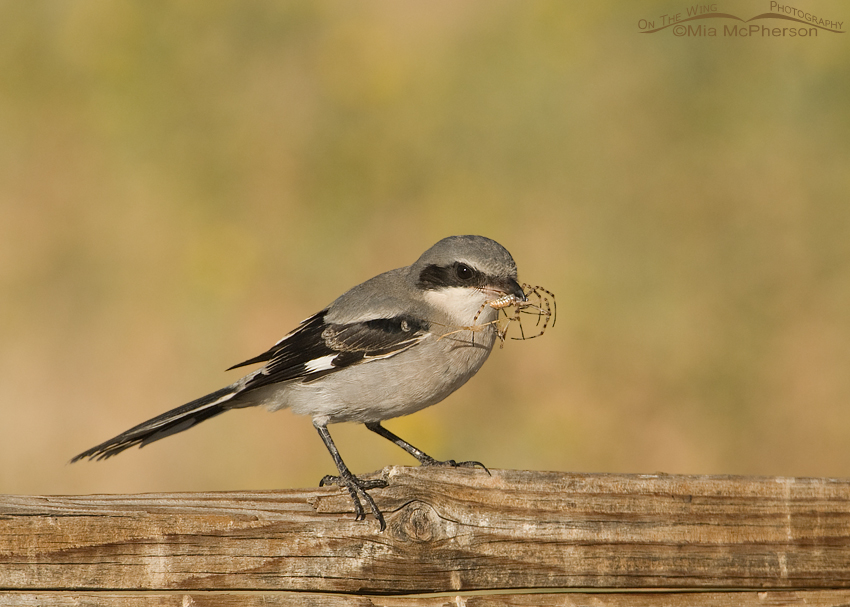 Loggerhead Shrike with spider – Nikon D200, f7.1, 1/1000, ISO 400, Nikkor 200-400mm VR with 1.4x TC at 400mm, natural light
Loggerhead Shrike with spider – Nikon D200, f7.1, 1/1000, ISO 400, Nikkor 200-400mm VR with 1.4x TC at 400mm, natural light
I’m self taught so I can’t speak about taking workshops but they do seem to help some people. Learn your camera & gear intimately, know when you are pushing it to its limits. I’ve heard other experienced bird photographers jokingly tell aspiring bird photographers to “sleep” with their gear to become familiar with it. Maybe they weren’t joking!
Know the level of your own skills.
You need to be able to change your settings very quickly as birds aren’t high paid fashion models, birds are wild and move whenever, however and where ever they want. An added plus is that birds are not prima donnas.
For me a large part of the joy I get photographing birds is being out in nature with them and immersing myself in the bird’s world.
Be aware that light can be your enemy or your friend when it comes to bird photography. Learn to work with it rather than fight it.
You can probably learn from books, workshops or instructional CD’s but they are no substitute for “Practice, practice, practice”.
If you don’t have patience bird photography might not be for you.
A sense of humor helps. Without it you may go batty and bats do not have feathers despite their ability to fly.
Be prepared to see the MOST amazing things while out photographing birds. Also be prepared to make a lot of lifelong friends with other bird photographers and birders.
Be prepared to become addicted to birds. You will have withdrawals if you don’t shoot often enough, your shutter button finger will develop a nervous twitch and your left eye lid will close when ever a bird flies by.
There is no Bird Photographers Anonymous. I don’t need support for my addiction thank you very much!
Hi, I am Mia and I am a bird photography addict!
So, do ya still wanna be a bird photographer?
Mia
Click here to see more of my bird photos.


Mia,
well said Mia the two most important things for this bird photographer are time in the field and practice and more practice.
I enjoy just being “out there” as well, if it’s a “slow day” so what.
Passion and love for nature has become second nature for me.
Hi Mia, I just love this post! I am still learning but I have already had the glory of being knee deep in stinking mud/bird faeces or dripping with sweat in 40 degree (Celsius – I’m in OZ) heat waiting for that shot! It IS an obsession and I love it too. Your photos are amazing and I love that you don’t have any fancy gear or bait your birds in (I too believe that you let the birds do what they do and just make sure you are there when it happens!). Cheers, G
Oh my gosh….I was so worried that he needed professional help! Sitting in the field in what he called a blind…for hours with his camera..giving us the evil eye if we called out to inquire if he needed water.
There are more of you bird photographers out there and I am so glad to hear that he is not the only one! Thanks for the good eye opener article. .it explains alot.
Hi! Great lesson today! love all of them and your works and teachings1 Have a great day!
I love this. Great page and well said. You had me relating to you, laughing with you, and wanting to learn from you. Great stuff!
Matthew, I am glad you laughed and related to me in this post. Believe me, I was laughing quite often as I wrote it. Bird photography is my passion. Thanks much for your comment.
You are sooooooo dead on in this article,,,,,The only thing I think you could add is ,,Take “ALOT” of photos,,,,,,,the one you didn’t shoot several frames of just might have been you personal best!
It takes birds! But your surely have all the birds one can desire and all the other characteristics required as well as evidenced by these marvelous photos. That first one is a work of art!
Thank you Merrill, you comment on this post and images are very much appreciated.
Hahahahahaha!!! What a great post!!
i bore people also…with botanical talk & nomenclature. Isn’t it amazing how people just don’t get it?
I’m glad you enjoyed this post Zephyr, I had a great deal of fun writing it!
Mia as a newbie (not even yet to 101, I am so green) I loved this. So far I have NONE of the required skills except tenacity and addiction. However, there is no happier feeling in the entire world than to be out with the babies respectfully enjoying them, so I plan to continue on. I very much enjoyed your remarks on ethics and would encourage you to write an entire post on that subject if you haven’t done so already.
Jennifer,
Thanks so much for commenting on this post, I had a lot of fun writing it up. You will develop the skills, it just takes time and heaps of practice. It sounds like you are already addicted! I may in the future write up a post just on ethics, I feel they are very important.
Mia – are we related? – is it possible we were seperated at birth? – the content of your article was so familiar, I felt as though I’d written it myself. Thank you.
Carl, I don’t know about being related but I believe all bird photographers who get out into the wild to photograph and learn about their subjects are connected. I’m glad you enjoyed this post and thanks for visting and commenting.
OMG, LOL!
Everything you’ve MENTIONED is so right on!
Just by itching your nose in a split second UGH!
Lots of blurred photos but worth the great ones
You get!
I thoroughly enjoyed reading and laughed my butt
Off!Not to mention great photography!
Deana Meadows
Deana, thanks so much for your comment and for stopping by. I’m happy that you laughed your butt off reading this, I know I laughed mine off writing it!
Love this…
Too funny about the “your left eye lid will close when ever a bird flies by” LOL and I already do drive eratically..constantly looking up and pulling off to shoulder so suddenly other drivers think I’ve had a heart attack, in which case, their honking wouldn’t have been very helpful.
Deb,
My left eye is going to be blinking for the next few days as the weather isn’t so great at the moment, but even when it is cloudy, gray and the light stinks I can not seem to stop looking for birds everywhere I go! Yes, the honking horns wouldn’t be helpful at all.
Mia, this article is so hilarious & true to life! I’m still in my early years of being a bird photographer, so I’m having major “lens envy”, 2nd mortgage huh? LOL I especially loved this statement,
“Be prepared to become addicted to birds. You will have withdrawals if you don’t shoot often enough, your shutter button finger will develop a nervous twitch and your left eye lid will close when ever a bird flies by.” I have discovered that it is soooooo true!
Karen,
I had so much fun writing this post, I laughed a lot while it was being written. I revised it and posted it on BirdingIsFun.com where I am a contributor to the multi-author blog. It is a great resource for birders and bird photographers.
http://www.birdingisfun.com/2011/11/so-ya-think-ya-want-to-be-bird.html
I’ve been having withdrawls for a couple of days due to an inversion in the valley, I keep hoping that we will get a storm to blow the inversion out, in the mean time my shutter button finger it twitching and my left eye lids keep closing!
Mia, absolutely, with all my heart. I’ve wanted to get started with bird photography for awhile now. I think your article got my butt out of the chair. Thanks!
Great Shannon!
Mia:
Fantastic! I’m sure you had more fun writing it than I had reading it, but not by much. I’m sending a few new converts to bird photography your way.
Dave, I had a lot of fun writing that post, I laughed myself silly. I’m thinking of doing a sequel to it because there is SO much more I could write about bird photography that is funny.
awesome shots and advice, I have been blessed to get some eagle shots from a cliff in Idaho looking down into the nest with permission on private property, I have a canon 7D and am learning patience for bird photography. I love your website.
Thanks for stopping by my site Gayle and for your kind words about it and my photos. It must be great to be able to look down into a Bald Eagle nest, I would love to do that. Patience, pratice and and a passion for birds go along way in bird photography!
Found your site through a Flickr contact!! Great info and love the way you tell it straight. I can’t agree with you more about what it takes to be a bird photographer, especially the time in the field (the one thing I can never get enough of between work and kids, luckily I have a supportive wife). You’ll never get the great shots at home on your couch. The only other thing I would add is that the more serious you get, the more expensive it gets. I have forgone a lot of things to save money for the next piece of gear on my wish list at B&H :o)
Rob, thanks for stopping by my blog, I had a great time writing this article. I sure wish I could afford all the long lenses Nikon has!
I like what you wrote! Totally agree!
This is so true and what I say to myself and friends all the time.
Your photos are excellent, and your information is something I wish I could have written myself.
I have to link this site on both my blogs now Thanks!
Very entertaining and very accurate, well written Mia. I can relate to this because I just got interested in photographing birds last year and what an interesting year it has been. This article made me laugh because it is really so true. Well got to go, skipping out of work early to go photograph some birds I spotted yesterday.
The answer is most certainly YES! You’ve summed it all up nicely and with humor….I was hanging on every word, embracing my new identity as a bird photographer and realizing there is no turning back. Thanks for sharing!
Excellent, truthful, and brutally honest, and oh yes, pretty darned funny. Great job Mia, I think you nailed our species pretty well!
OUTSTANDING – and absolutely, most positively 100% accurate!